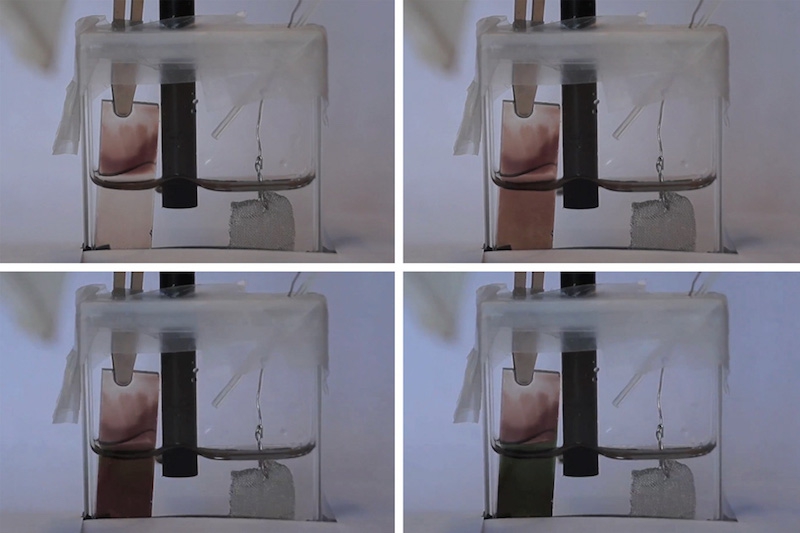
News
Self-shading windows require no power for their new state of being
August 11, 2016 - A team of MIT researchers has developed a new way of making windows that can switch from transparent to opaque, potentially saving energy by blocking sunlight on hot days and, by extension, reducing air-conditioning costs.
August 11, 2016 By Anthony Capkun
 Image courtesy Khalid Abdulaziz Kaabi and Dennis Sheberla.
Image courtesy Khalid Abdulaziz Kaabi and Dennis Sheberla. While other systems for causing glass to darken already exist, the new method combines rapid response times with low power needs. Once the glass is switched from clear to dark (or vice versa), the new system requires little to no power to maintain its new state; unlike other materials, it only needs electricity when it’s time to switch back again.
The new discovery uses electrochromic materials, which change colour and transparency in response to an applied voltage, explained MIT’s Mircea Dinca. Existing electrochromic materials have found only niche applications, explains MIT.
For example, Boeing 787 aircraft have electrochromic windows that get darker to prevent bright sunlight from glaring through the cabin. The windows can be darkened by turning on the voltage, Dinca explained, but “when you flip the switch, it actually takes a few minutes for the window to turn dark. Obviously, you want that to be faster”.
The reason for the slowness is that changes within the material rely on a movement of electrons that gives the whole window a negative charge. Positive ions then move through the material to restore the electrical balance, creating the colour-changing effect. But while electrons flow rapidly through materials, ions move much more slowly, limiting the overall reaction speed.
The MIT team overcame that challenge by using sponge-like materials called metal-organic frameworks (MOFs), which can conduct both electrons and ions at very high speeds. Such materials have been used for about 20 years for their ability to store gases within their structure, but the MIT team was the first to harness them for their electrical and optical properties.
The other problem with existing versions of self-shading materials, Dinca explained, is that “it’s hard to get a material that changes from completely transparent to, let’s say, completely black”. Even the windows in the 787 can only change to a dark shade of green rather than become opaque.
In previous research on MOFs, Dinca and his students made material that could turn from clear to shades of Blue or Green, but in this new work they have achieved their goal of producing a coating that can go all the way from perfectly clear to nearly black (achieved by blending two complementary colours, Green and Red). The new material is made by combining two chemical compounds, an organic material and a metal salt. Once mixed, these self-assemble into a thin film of the switchable material.
“It’s this combination of these two—of a relatively fast switching time and a nearly black colour—that has really got people excited,” Dinca said.
The new windows have the potential, he says, to do much more than just prevent glare.
“These could lead to pretty significant energy savings,” he said, by drastically reducing the need for A/C in buildings with many windows in hot climates. “You could just flip a switch when the sun shines through the window and turn it dark,” or even automatically make that whole side of the building go dark all at once.
While the properties of the material have now been demonstrated in a laboratory setting, the team’s next step is to make a small-scale device for further testing (a 1-square inch sample) to demonstrate the principle in action for potential investors in the technology, and to help determine what the manufacturing costs for such windows would be.
Further testing is also needed, Dinca says, to demonstrate what they have determined from preliminary testing: that once the switch is flipped and the material changes colour, it requires no further power to maintain its new state. No extra power is needed until the switch is flipped to turn the material back to its former state, whether clear or opaque. Many existing electrochromic materials, by contrast, require a continuous voltage input.
— With files from David L. Chandler, MIT News Office. Image courtesy Khalid Abdulaziz Kaabi and Dennis Sheberla.
Print this page